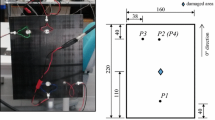Abstract
A non-destructive method for the evaluation of material properties of a rectangular, anisotropic, homogeneous plate with four free edges is presented. The method consists of two steps. In the first step, a certain number of the plate's natural frequencies are experimentally measured. In the second step, the plate rigidities are varied in a theoretical model, so that the calculated natural frequencies match as close as possible the corresponding experimental values. Two such models are presented, based on the Classical Lamination Theory and on a Higher Order Shear Deformation Theory. High order Lagrange polynomials are used as deflection functions and the Rayleigh-Ritz procedure is employed to arrive at the solution. The identification of the plate rigidities is done by means of an iterative Bayesian parameter estimation method, where possible measurement errors or rigidities' uncertainties can be taken into account.
Similar content being viewed by others
References
Wearing, J. L. and Patterson, C., ‘A Combined Experimental and Numerical Technique for the Determination of the Material Properties of Laminates’, in Proceedings of the Second Int'l Conference on Composite Structures, I. H. Marshall (ed.), Applied Science Publ. Ltd, London, 1983.
Sol, H., ‘Identification of Anisotropic Plate Rigidities Using Free Vibration Data’, Ph.D. Thesis, Vrije Universiteit Brussels, Belgium, 1986.
De Wilde, W. P. and Sol, H., ‘Identification of the Elastic and Damping Properties of Orthotropic Composite Materials by Vibration Analysis’, Charactérization Mécanique des Composites, Extensometrie Appliquée aux Composites, Comptes Rendus des Journées Nationales AMAC-GAMAC, Pluralis, Saint-Etienne, France, 1989.
Lai, T. C. and Lau, T. C., ‘Determination of Elastic Constants of a Generally Orthotropic Plate by Modal Analysis’, Modal Analysis: The Int. J. of Analytical and Experimental Modal Analysis 8, 1993, 15–33.
Jones, R. M., Mechanics of Composite Materials, Hemisphere Publ. Corp., New York, 1975.
Reddy, J. N., ‘A Refined Nonlinear Theory of Plates with Transverse Shear Deformation’, Int. J. of Solids and Structures 20, 1984, 881–896.
Lazaridis, A. G., ‘A Non-Destructive Method for the Material Properties Identification of Thick Orthotropic Plates’, Diploma Thesis, Dept. of Naval Architecture and Marine Engineering, National Technical University of Athens, under preparation.
Tsouvalis, N. G., ‘A Non-Destructive Method for the Identification of Anisotropic Plate Elastic Properties’, Report No DITI 91.17 GO/MM, Institut Français de Recherche pour 1'Exploitation de la Mer (IFREMER), Centre de Brest, France, 1991.
ADINA, ‘A Finite Element Program for Automatic Dynamic Incremental Nonlinear Analysis: User's Manual’, Report AE 84-1, ADINA Engineering, 1984.
Blevins, R. D., Formulas for Natural Frequency and Mode Shape, Van Nostrand Reinhold Co., 1979.
Press, W. H., Flannery, B. P. et al., Numerical Recipes: The Art of Scientific Computing, Cambridge Univ. Press, London, 1986.
Author information
Authors and Affiliations
Rights and permissions
About this article
Cite this article
Papazoglou, V.J., Tsouvalis, N.G. & Lazaridis, A.G. A non-destructive evaluation of the material properties of a composite laminated plate. Appl Compos Mater 3, 321–334 (1996). https://doi.org/10.1007/BF00134974
Issue Date:
DOI: https://doi.org/10.1007/BF00134974




